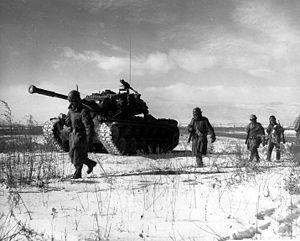Battle of the Changjin Reservoir

A line of riflemen from the U.S. 1st Marine Division moves through the Chinese lines during their breakout
| date | November 26th to December 13th 1950 |
|---|---|
| place | Changjin Reservoir , North Korea |
| output | Chinese Pyrrhic Victory |
| Parties to the conflict | |
|---|---|
| Commander | |
| Troop strength | |
| approx. 40,000 soldiers | 120,000 |
| losses | |
|
1,029 dead |
25,000 dead |
The Battle of Changjin Reservoir (better known by the Japanese-American name Chosin Reservoir ) was a battle during the Korean War , shortly after the Chinese entered the conflict. A large number of Chinese soldiers came over the River Yalu in the surrounding of the Changjin Reservoir and kesselte there, the UN forces (especially the United States ) a. A brutal battle in the freezing cold ensued. Although the outnumbered US forces inflicted huge losses on the Chinese forces, they were forced to withdraw from North Korea very quickly .
background
In mid-October 1950 it looked like the Korean War was drawing to a close. North Korea was largely occupied by the American-led UN troops. However, this changed abruptly when the People's Republic of China entered the conflict on October 19, 1950 and a large number of Chinese troops invaded the Korean Peninsula via the northern North Korean border . The UN troops, whose main units were the 1st Marine Infantry Division , the 7th US Infantry Division and the 41st Independent Commando of the Royal Marines , were soon joined by the units of the 9th Army Group of the Chinese People's Liberation Army , which consisted largely of volunteers , encircled. On November 26th, the UN troops began fighting to retreat south towards Hangnam .
The battle
The 20,000 well-armed and air-supported soldiers of the UN forces met 200,000 poorly equipped but well-organized soldiers of the People's Liberation Army. In the heavy fighting that lasted until December 11, 2,500 UN soldiers were killed, 5,000 wounded and 7,500 others suffered from frostbite. About 25,000 Chinese were killed, 12,500 wounded, and 30,000 died from frostbite.
After the 7th Infantry Division withdrew and left their equipment behind, the 1st Marine Division, along with the Royal Marines and the South Korean Marines , picked them up again, turned back and launched an aggressive counter-attack to break out of the pocket.
When asked if the US Marines would withdraw like the Army, Lieutenant General Oliver P. Smith , commander of the 1st Marine Division , replied that attempting to break through Chinese lines should not be confused with withdrawing. General Smith's remarks have been shortened to the familiar quote: “ Retreat, bright! We're only attacking in a different direction! "(=" Withdrawal, to hell with it! We're just attacking in a different direction! "). This saying is based on a quote from the First World War by Captain Lloyd Williams during the Battle of Belleau Forest : “ Retreat, hell! We just got here! "(=" Retreat, to hell with it! We have only just arrived! ")
As they retreated, the Marines had constant air support from Navy and Marine Corps aircraft and were able to either destroy or incapacitate all seven Chinese divisions they had encircled in the reservoir area. Despite their weakened condition, the Chinese were able to engage the US Marines in fighting on their retreat to the Sea of Japan, but the UN troops reached the evacuation zone around Hŭngnam undisputed and were able to withdraw in order to continue fighting in South Korea.
consequences
While the Chinese succeeded in driving the UN troops back from the area, the US marines inflicted heavy losses on them as they withdrew. The withdrawal was made possible in part with the help of soldiers of Chinese descent who eavesdropped on Chinese radio traffic.
The marines who left the area because of the equipment left behind by the 7th Infantry Division with more equipment than they initially possessed were able to safely exit North Korea. The Chinese consider the battle to be very honorable to this day, despite the high casualties, as the Chinese army succeeded in defeating a Western army in a major battle for the first time in the 20th century. The US Marines also regard the battle for the Chosin Reservoir as one of the proudest chapters in their history, despite the high casualties to this day.
literature
- Roy Appleman: Escaping the Trap 1990, ISBN 0-89096-395-9 .
- HW Crocker: Don't Tread on me: A 400-year history of America at War, from Indian Fighting to Terrorist Hunting . Crown Forum, 2006, ISBN 1-40005-363-3 .
- TR Fehrenbach: This Kind of War . Brassey's, Dulles, Virginia 1963, ISBN 1-57488-259-7 .
- David Halberstam: The Coldest Winter - America and the Korean War . Hyperion, New York 2007, ISBN 978-140130-052-4 .
- Martin Russ: Breakout - The Chosin Reservoir Campaign, Korea 1950 . Penguin Books, 1999, ISBN 0-14029-259-4 .
- Schnabel, James F .: Policy and Direction: The First Year. (= US Army in the Korean War). Center of Military History, US Army, Washington, DC 1988.
- Neil Sheehan: A Bright Shining Lie: John Paul Vann and America in Vietnam . Random House, New York 1988, ISBN 0-67972-414-1 .
- Wayne E. Webb: Cannon and Rifle: The Story of King Battery in Korea - 1950 . 1998.
- Patrick C. Roe: The Dragon Strikes . Presidio, May 4, 2000, ISBN 0891417036 .
- Bob Drury: The Last Stand of Fox Company . Atlantic Monthly Press, January, 2009, ISBN 9780-87113-993-1 .
- Simmons, BGen Edwin H. (2002) Frozen Chosin pt1 pt2 pt3 , United States Marine Corps Historical Division. PCN 19000410000.
Movies
- Randall MacLowry: American Experience: Battle for the Changjin Reservoir . United States 2016.
Web links
- Information at chosinreservoir.com (English)
